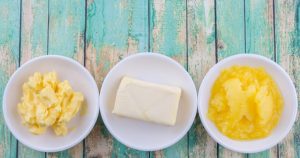Healthier: Butter or Margarine?
For many years, both experts and customers have been debating the advantages and disadvantages of butter vs margarine as the healthier choice. In order to address this subject, it is imperative to examine butter and margarine in a fair manner while recognizing the historical background of margarine manufacture and the noteworthy developments that have occurred recently.
Comparison of Butter and Margarine: A Historical Viewpoint

First off, it’s critical to recognize the history of margarine, which has changed dramatically since its beginnings. A more reasonably priced substitute for butter was created in the 19th century: margarine. Because margarine was highly processed and included trans fats in its early versions, its health effects were seen negatively. But because to improvements in manufacturing techniques and food technology, trans fats—a once-unsettling ingredient—have been removed from modern margarine products. This change has improved margarine’s nutritional profile generally considerably.
Recognising the Nutrient Profile
It’s critical to know the nutritional differences between butter and margarine when comparing them. High in saturated fat, butter has generated debate about its possible effects on heart health. Conversely, margarine is high in unsaturated fats and, in most current formulations, does not include trans fats. Trans fats have been scientifically connected to negative health impacts, hence the removal of them from margarine is a big improvement.
Analyzing Scientific Point of Views
Its high omega-6 polyunsaturated content has been one of the main worries about margarine. Certain sections have proposed that a high omega-6 consumption could increase inflammatory levels. It is important to remember, nevertheless, that controlled research do not usually back up this idea. This nuance underlines the complexity of nutrition science and the ongoing need for comprehensive research to fully discern the implications of various dietary components.
Modern Scenery
Many margarine products have been altered to be trans-fat-free in recent years using healthy oils like olive oil as worries about trans fats have gained widespread attention. The nutritional value of margarine has been much enhanced by this development in its manufacturing methods. To further expand the alternatives available to customers, there are now premium butters produced from cows raised on grass.
Moderation and Choice of the Customer
Ultimately, diet and personal tastes may determine which of butter and margarine to use. Both alternatives, while the argument rages on, can, when used sparingly, be a component of a healthy diet. Important considerations when adding these spreads to a balanced diet include selecting trans-fat-free margarine and goods derived from healthy oils, as well as premium butter.
The Final Verification
The debate over butter and margarine is a perfect example of how nutrition is complicated and how food products are always changing. It is evident that margarine has changed significantly, dispelling the unfavorable impressions connected to its early versions with the addition of healthy components and the reformulated trans-fat-free choices. In the end, knowing the unique qualities of each choice and making educated decisions are essential as food technology and consumer knowledge develop.





